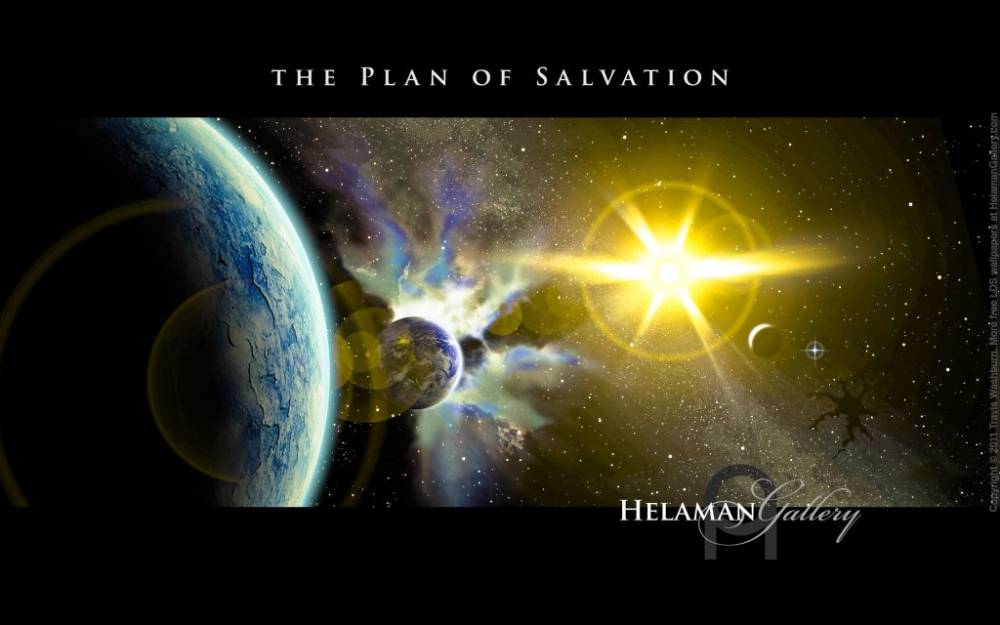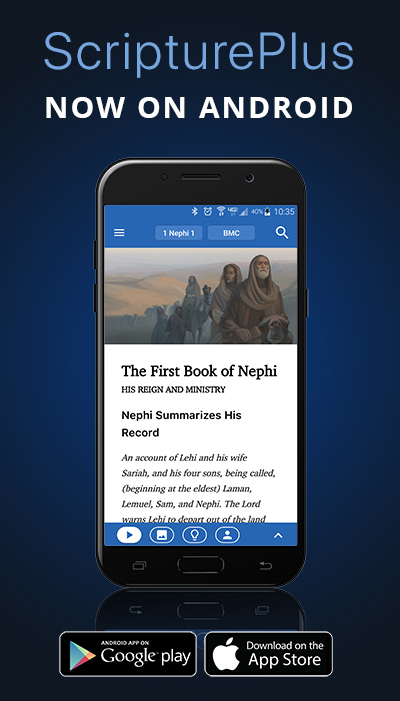/ KnoWhys / KnoWhy #312
Why Are There So Many Different Names for the Plan of Salvation?

Post contributed by BMC Team
May 12, 2017
D&C KnoWhy #312

“For behold, if Adam had put forth his hand immediately, and partaken of the tree of life, he would have lived forever … and the great plan of salvation would have been frustrated … for that would destroy the great plan of happiness. … Therefore, according to justice, the plan of redemption could not be brought about, only on conditions of repentance of men in this probationary state … . And now, the plan of mercy could not be brought about except an atonement should be made.”
The Know
For centuries, a misunderstanding about God and the nature of His relationship to mankind prevailed. As Mormon historian Matthew McBride explained:
Since the fifth century, Christian orthodoxy had imposed an almost impassable gulf between the Creator and His creations. Humankind, Christians came to believe, was created from nothing. God was not a craftsman who refashioned existing materials but wholly different and apart from His creation—mysterious and unknowable.1
Then, on May 6, 1833, all that misunderstanding melted away in the face of revelation to the prophet Joseph Smith, now known as Doctrine and Covenants 93. This revelation, and others like it, showed people that they were literal spirit children of God who had lived with Him in the premortal realm, and that God had a plan for them to return to His presence to be like Him.2
The Doctrine and Covenants never gives a name to this plan that God put in place for His children. The Book of Mormon, however, refers to it by many names: “the merciful plan of the great Creator” (2 Nephi 9:6), “the plan of our God” (2 Nephi 9:13), “the great and eternal plan of deliverance from death” (2 Nephi 11:5), the “plan of redemption,”3 “the great plan of the Eternal God” (Alma 34:9), “the plan of restoration” (Alma 41:2), the “plan of happiness” (Alma 42:8,16), “the plan of mercy” (Alma 42:15,31), and “the plan of salvation” (Jarom 1:2; Alma 24:14; 42:5).4 A careful examination of each of these names can help people to better understand God’s plan for His children.5
Some names for the plan, such as “the plan of our God” (2 Nephi 9:13) and “the great plan of the Eternal God” (Alma 34:9), serve as reminders that God Himself put the plan in place, and the plan must therefore be followed.6 For example, Amulek taught, “according to the great plan of the Eternal God there must be an atonement made, or else all mankind must unavoidably perish; yea, all … must perish except it be through the atonement which it is expedient should be made” (Alma 34:9, emphasis added).

Other names, such as “the merciful plan of the great Creator” (2 Nephi 9:6), and “the plan of mercy” (Alma 42:15,31), show the benevolence of God in creating a plan to deal with forces such as death and sin that would otherwise hold eternal sway.7 As Alma explained to his son to “bring souls unto repentance, that the great plan of mercy may have claim upon them” (Alma 42:31).8
Names like “the great and eternal plan of deliverance from death” (2 Nephi 11:5), and “the plan of restoration” (Alma 41:2), show that the plan ensures that all people will be resurrected.9 Alma said “that the plan of restoration is requisite with the justice of God; for it is requisite and just, according to the power and resurrection of Christ, that the soul of man should be restored to its body” (Alma 41:2).
One name stands out as the most common name for the plan in the Book of Mormon: the “plan of redemption.” It appears in 15 different verses of the Book of Mormon. This name reminds readers that the plan offers redemption from sin and death.10 Alma, for example, taught that “if it had not been for the plan of redemption, which was laid from the foundation of the world, there could have been no resurrection of the dead” (Alma 12:25). He went on to explain: “God did call on men, in the name of his Son, (this being the plan of redemption which was laid) saying: If ye will repent, and harden not your hearts, then will I have mercy upon you, through mine Only Begotten Son” (Alma 12:33).
Two of the most common names for the plan today are “plan of happiness” (Alma 42:8,16), and “the plan of salvation” (Jarom 1:2; Alma 24:14; 42:5). These names demonstrate that even though parts of the plan are difficult to live up to, its ultimate objective is humanity’s happiness and salvation.11 Alma declared that “repentance could not come unto men except there were a punishment … affixed opposite to the plan of happiness” (Alma 42:16).12
The Why

The different names for the plan show how all-encompassing it is. Doctrine and Covenants 93:24, paraphrasing Jacob 4:13, states that “truth is knowledge of things as they are, and as they were, and as they are to come.” This is what a knowledge of the plan imparts: knowledge of what humanity is now, where they came from before, and where they will be going after this life.13 The names for this plan in the Book of Mormon help illuminate the purpose of life, but also reveal the true nature of God in all its richness and fullness. The great plan of the Father is all the things its names imply, the one greatest whole, not just a few of its parts. Yet these names also reveal the true nature of God in all its richness and fullness.
Because God the Father Himself put the plan in place, the plan is guaranteed to be implemented, and people can have complete faith in God that he will keep his promises. Because the plan allows all people to be resurrected, people can confidently know that death is not the end. Because the plan shows the mercy of God, people can have faith that this mercy will never fail them.14 Because the plan provides a sure way of redemption from sin and death, people can have hope that they can be freed from the evils of mortality. Because the ultimate objective of the plan is humanity’s happiness and salvation, people can make it through difficult times, knowing that with God’s help, things will eventually work out.
Joseph Smith’s revelations, in conjunction with the Book of Mormon, give an expansively broad view of God’s plan, and of humanity’s place in the universe. Knowledge of the many different facets of the plan can provide comfort and hope in a complex world that appears, at times, to be chaotic. But people’s spirits existed together before they came into this mortal and temporal state on earth, and they will continue to exist and to thrive one with another after this stage of being, on into eternity, worlds without end. As Joseph Smith declared: “The soul, the mind of man, where did it come from? The learned says God made it in the beginning, but it is not so. I know better, God has told me so … You who mourn the loss of friends, are only separated for a moment.”15
Further Reading
Matthew McBride, “‘Man Was Also in the Beginning with God’,” in Revelations in Context: The Stories Behind the Sections of the Doctrine and Covenants, ed. Matthew McBride and James Goldberg (Salt Lake City, UT: The Church of Jesus Christ of Latter-day Saints, 2016), 192–195.
M. Catherine Thomas, “Plan,” in Book of Mormon Reference Companion, ed. Dennis L. Largey (Salt Lake City, UT: Deseret Book, 2003), 642–643.
Corbin T. Volluz, “Cry Redemption: The Plan of Redemption as Taught in the Book of Mormon,” Journal of Book of Mormon Studies 3, no. 1 (1994): 148–169.
1. Matthew McBride, “‘Man Was Also in the Beginning with God’,” in Revelations in Context: The Stories Behind the Sections of the Doctrine and Covenants, ed. Matthew McBride and James Goldberg (Salt Lake City, UT: The Church of Jesus Christ of Latter-day Saints, 2016), 193.
2. Joseph Fielding McConkie and Robert L. Millet, Doctrinal Commentary on the Book of Mormon, 4 vols. (Salt Lake City, UT: Bookcraft, 1987–1992), 3:94.
3. Jacob 6:8; Alma 12:25, 26, 30, 32, 33; 17:16; 18:39; 22:13; 29:2; 34:16, 31; 39:18; 42:11, 13.
4. It’s possible that this comes from Moses 6:62 through the plates of brass.
5. For more on the development of the Plan of Salvation in the Book of Mormon, see Book of Mormon Central, “When Does the Book of Mormon First Talk about the Plan of Salvation? (2 Nephi 9:6),” KnoWhy 33 (February 15, 2016).
6. For more on this, see Book of Mormon Central, “Where Can You Best Learn about God’s Plan of Salvation? (Alma 24:14),” KnoWhy 272 (February 8, 2017).
7. Robert J. Matthews, “The Atonement of Jesus Christ: 2 Nephi 9,” in Second Nephi, The Doctrinal Structure, ed. Monte S. Nyman and Charles D. Tate Jr., The Book of Mormon Symposium Series, Volume 3 (Provo, UT: Religious Studies Center, Brigham Young University, 1989), 180–183.
8. For more on the use of the word plan in Alma 42, see Book of Mormon Central, “Why Does Alma Mention ‘the Plan’ Ten Times in His Words to Corianton? (Alma 42:13),” KnoWhy 150 (July 25, 2016).
9. For more on this see Robert L. Millet, “Justice, Mercy, and the Life Beyond: Alma 40–42,” in The Book of Mormon, Part 2: Alma 30 to Moroni, ed. Kent P. Jackson, Studies in Scripture: Volume 8 (Salt Lake City, UT: Deseret Book, 1988), 56–68.
10. Yet it only provides this if people choose to place faith in Christ and repent of their sins. See Alma 11:34–37. See also, Hugh Nibley, An Approach to the Book of Mormon, The Collected Works of Hugh Nibley, Volume 6 (Salt Lake City and Provo, UT: Deseret Book and FARMS, 1988), 202–204.
11. See Brant A. Gardner, Second Witness: Analytical and Contextual Commentary on the Book of Mormon, 6 vols. (Salt Lake City, UT: Greg Kofford Books, 2007), 4:555.
12. For the textual variants in this verse, see Royal Skousen, ed., The Book of Mormon: The Earliest Text (New Haven, CT: Yale University Press, 2009), 770. For Skousen’s analysis of these variants, see Royal Skousen, Analysis of Textual Variants of the Book of Mormon: Part 4, Alma 21–55 (Provo, UT: FARMS, 2006), 2440–2441. To see this verse in the original manuscript, see Royal Skousen, ed. The Original Manuscript of the Book of Mormon: Typographical Facsimile of the Extant Text (Provo, UT: FARMS, 2001), 355. To see it in the printer’s manuscript, see Royal Skousen, ed., The Printer’s Manuscript of the Book of Mormon: Typographical Facsimile of the Extant Text in Two Parts (Provo, UT: FARMS, 2001) 2:597. To see a photo of the actual page this is on, see Royal Skousen and Robin Scott Jensen, eds., Revelations and Translations Volume 3, Part 2: Printer’s Manuscript of the Book of Mormon, Alma 36–Moroni 10, The Joseph Smith Papers (Salt Lake City, UT: Church Historian’s Press, 2015), 27.
13. Gerald N. Lund, “Plan of Salvation, Plan of Redemption,” in Encyclopedia of Mormonism, ed. Daniel H. Ludlow, 4 vols. (New York, NY: Macmillian Publishing, 1992), 3:1088–1091.
14. Ed J. Pinegar and Richard J. Allen, Commentaries and Insights on the Book of Mormon: Alma 30–Moroni (American Fork, UT: Covenant Communications, 2003), 92–93.
15. Discourse, 7 April 1844, as Reported by Wilford Woodruff, p. 137, online at josephsmithpapers.org, spelling and punctuation standardized.

